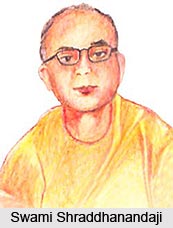 Swami Shraddhanandaji was born in the East Bengal in the year 1907. This popular saint had the passion of organizing seminars, for studying the teachings of Ramakrishna and Swami Vivekananda, in his childhood. He also had the habit of singing devotional songs in his childhood and he spent most of his time from 1925 to 1937, at the Kolkata Student Home. He stayed there first as a student and later as a monk and worker.
Swami Shraddhanandaji was born in the East Bengal in the year 1907. This popular saint had the passion of organizing seminars, for studying the teachings of Ramakrishna and Swami Vivekananda, in his childhood. He also had the habit of singing devotional songs in his childhood and he spent most of his time from 1925 to 1937, at the Kolkata Student Home. He stayed there first as a student and later as a monk and worker.
Swami Shraddhanandaji was initiated into the Ramakrishna Mission at the young age of 23 years and he developed his spiritual knowledge under the proper guidance of Swami Shivananda, in the mission. He adopted the life of Sanyasa from Swami Viyayanandaji in the year of 1939 and then he took up the work of editorship of `Udbhodhan` magazine of the Ramakrishna order.
After spending considerable time on serving the common people on behalf of the Ramakrishna Mission, Swami Shraddhanandaji went out for travelling the important cities of the world and he went to United States of America as assistant minister of Vedanta Society of Northern California in 1939. He bore the responsibilities of the Head of the Vedanta Society of Sacramento from the years of 1964 to 1996. He was very well versed in Vedanta philosophy and the teachings of the Ramakrishna Order and he has also written a lot of books related to it in Bengali. He left the earthly abode in the year of 1996.
This article is a stub. You can enrich by adding more information to it. Send your Write Up to content@indianetzone.com




















